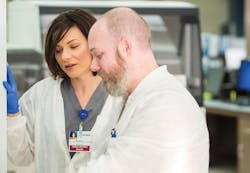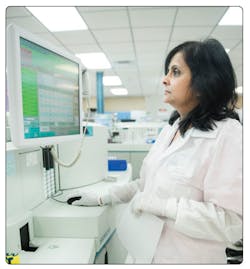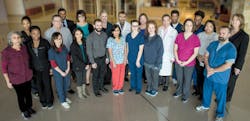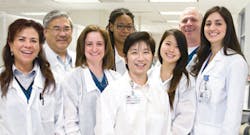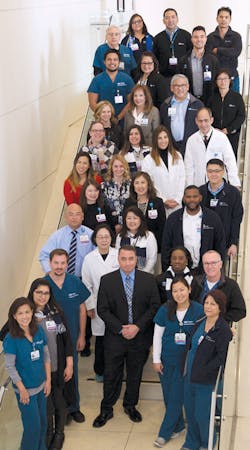The competition was tough, the judging was not easy—but MLO is proud to present the 2018 Lab of the Year: St. Luke’s Health System’s Core Laboratory.
St. Luke’s Health System (SLHS) is a not-for-profit, locally owned health system serving southern Idaho and eastern Oregon. St. Luke’s Core Laboratory was established in 2011 and is a department of SLHS. The laboratory includes five physical locations in Boise, Idaho; one main testing site, and four outreach phlebotomy sites.
Prior to 2011, all laboratory testing was performed within the hospital environment; the creation of the core laboratory provided SLHS the opportunity to centralize outpatient and routine testing to improve efficiency across the corporation. The laboratory has 72 FTEs who provide five primary services: outreach phlebotomy; specimen testing; courier services; specimen processing/esoteric testing (send-outs); and client service.
Specimen testing is further subdivided into distinct departments:
- Hematology/Chemistry/Immunology
- Microbiology
- Molecular Biology
- Cytology.
Major testing platforms include technology provided by such industry leaders as Sysmex, Hologic, BD, Siemens, Beckman Coulter, Ortho Clinical Diagnostics, Diasorin, and Tosoh.
Test volume has increased 45 percent over the last four years, with 1,177,369 billable tests having been performed in FY17.
The laboratory has defined three strategic challenges—ones which, we suspect, are faced by many if not most of MLO’s readers:
- Reducing reimbursement: Insurance fee schedules continue to decline, limiting revenue for inpatient and outpatient testing.
- Volume to value: Networks and insurers are partnering with laboratories within per member, per month reimbursement models.
- Workforce shrinkage: The national average age of the technical workforce is 54, with more individuals leaving the field through retirement than entering as new graduates. More than half of the NAACLS-approved (National Accrediting Agency for Clinical Laboratory Science) medical lab scientist programs in place in 1980 have closed, with worker tenure reduced by half.
Those are the basics; now let’s look at St. Luke’s Health System’s Core Laboratory more closely. MLO asked labs submitting nominations to discuss their lab in terms of six criteria: Customer Service, Productivity, Teamwork, Education and Training, Strategic Outlook, and Lab Inspections. To organize the rest of this article, we will use those categories as sub-sections and review some highlights.
Customer Service
Laboratory data is delivered according to provider preference. In addition to faxing and the U.S. mail, SLHS provides:
- EPIC Inpatient/EPIC Ambulatory: interfaced results directly to the inpatient and outpatient electronic medical records utilized by SLHS
- EpicCare Link: online portal for independent providers to access patient laboratory data
- Direct Interface to outside EHR: interfaced results between Epic Beaker and a contracted client.
Also, patient results are delivered via patient portal and can be accessible by patients or their proxies. The Idaho Health Data Exchange connects health systems, hospitals, providers, laboratories, and imaging centers in Idaho, eastern Washington, and eastern Oregon to electronically and securely share patient medical records.
Laboratory liaison. The lab also has a dedicated liaison that engages with customers in a variety of forms to listen, determine customer satisfaction, and capture information regarding opportunities to exceed expectations. The primary responsibilities of the liaison include:
- Clinic rounding: meets with clinic staff, leadership and providers discuss service and quality performance according to a scrupulously observed rounding schedule which has increased by more than 80 percent since FY16Q4.
- New product training: uses laboratorian background to provide expert knowledge on lab testing and products
- Lunch and learn: offers provider education on new testing and technology that is available at the core laboratory
- Customer quarterly business reviews: schedules face-to-face meetings with top 10 high-volume clinics to review call center, courier, testing volume, and error data
- Laboratory open house: schedules periodic open-house events for customers to view new technology and processes.
The laboratory liaison partners with the Community Connect liaison to meet with potential clients about using the EPIC ambulatory medical record and the availability of the Core Lab to provide interfaced high quality results to potential clients. Additionally, the physician liaison team facilitates quarterly continuing education events for the broader medical staff. The liaison partners on ensuring that appropriate laboratory medicine topics are integrated within the overall plan and ensures that potential customers are included.
The St. Luke’s website includes information for both ordering providers and patients. Providers have access to the organization’s complete test menu, which includes collection, transport, and turnaround time information. Patients can find laboratory locations and hours of operation.
Epic myChart is a patient portal that provides laboratory results directly to patients through a secure log-in.
Epic Care Link is an online portal for providers that enables access to patient results. Providers can access results for testing they have ordered or testing a colleague has
ordered electronically.
The Physician Liaison team coordinates quarterly CME events for providers, in which key topics are discussed. Popular topics include laboratory testing best practices for renal disease, diabetes, and infectious disease.
The Core Laboratory operates a Client Service Center which ordering physicians can call to schedule a home draw, request or add on a test, communicate a concern, or obtain patient testing results. Performance is tracked with call quality audits that were implemented in FY18. SLHS is proud that abandoned calls are kept to a minimum; the industry best practice benchmark performance for call centers is an abandonment rate of below five percent, and the core laboratory has performed below this benchmark in both FY16 (2.9 percent) and FY17 (3.8 percent).
The Chief Quality Officer authors a monthly Provider Newsletter with key updates for physicians. Laboratory updates include new testing methodologies, new laboratory policies, and best practice updates. The Safety is Why I Care Newsletter is produced by the St. Luke’s Quality & Patient Safety and Employee Safety teams and distributed to all hospital and clinic sites. Content focuses on safety opportunities in the SBAR format, encouraging staff discussion during staff meetings or daily huddles. Recently, a good catch by the core lab staff on erroneous STD results was highlighted.
Productivity
The core laboratory sets an annual budget built on internal and external benchmarking. Key monitors evaluated at the team and department level include:
- Worked and paid FTE
- Supply expense
- Total operating expense per test
- Total labor hours per test.
These metrics are reviewed during monthly 1:1 meetings, weekly leadership huddles, and monthly business review meetings with finance. Opportunities to optimize performance focus on technology solutions and workflow enhancements such as workstation alignment (processing), discontinuing low volume/high labor tests (microbiology), and test batching (molecular biology). These improvements/enhancements are considered when budget targets are set.
During the monthly business review meetings, cost management and customer needs are discussed, and sometimes hard choices are made. For example, the need to implement an additional courier route for a hospital customer was approved in support of improving turnaround times, even though it negatively impacted productivity. The laboratory has also transitioned away from traditional microbiology in support of molecular technology to reduce turnaround times; molecular technology can provide results in minutes, but is often three to four times more expensive. The laboratory has also continued to operate patient draw stations that perform at below benchmark productivity because having a convenient option for outpatient draws is important to their customers.
The core laboratory evaluates cycle time along the various steps in the testing process as indicators of process effectiveness. The first step in the process is specimen collection. SLHS has measured the cycle time in minutes from patient check-in through specimen collection for the core laboratory’s three outreach phlebotomy sites. Performance is compared to a benchmark of 10 minutes, and performance has been consistently at or below benchmark performance for all sites.
The second step in the process is transporting the specimen to the Core Laboratory for testing; on-time courier transport of specimens for routine routes (regularly scheduled for non-STAT/urgent testing) at the Core Lab exceeded the industry benchmark of 90 percent for all of FY17.
The third step in the process is to perform the testing at the Core Laboratory. For the three highest-volume tests performed by the Heme/Chem/IA department during FY17, SLHS has come in under the national benchmark. The same is true for the cycle time for urine cultures in the Microbiology department. The industry benchmark is to release results for urine cultures within 48 hours greater than 90 percent of the time, and the core lab has exceeded this standard since the beginning of 2017.
Improved cycle time performance, in addition to staff productivity, is supported by increased testing on automation lines. Both the Heme/Chem/IA and Microbiology departments have seen significant increases in automation since FY15.
Specimen testing ordered, but not performed, by the Core Laboratory is sent to an esoteric (highly complex) testing partner. The Core Laboratory tracks rejected specimens by such partners as an indicator of process effectiveness. Specimen rejection has been reduced from nearly four percent in October 2016 to 1.31 percent in October 2017.
Department productivity has improved significantly over the last three years. Supply cost improvements have positively impacted total cost-per-test improvements.
Teamwork
Lab leaders at SLHS strive to create an environment that is focused on optimizing performance both through a variety of internal processes and key collaborations. The internal processes include:
- Kola’s board. Named after the department’s director Kola Ogunrinola, PhD, the board displays service, quality, and financial performance for all work streams. The board is built upon three leadership commitments: know your process, know your numbers, and exceed expectations.
- Department scorecard. Tracking and analyzing of key metrics across all departments.
- Weekly leadership huddles. The Core Laboratory leadership team huddles to review key performance indicators, goal progress, and organizational change management initiatives.
- Weekly team huddles. Leaders and staff meet to review key performance indicators and goal progress and to discuss opportunities for improvement.
- Monthly 1:1. Staff and supervisors meet to review key performance indicators, goal progress, leadership development, and staff issues/trends.
- All-staff meetings. These are utilized to deploy important information to the workforce. Service, quality, and stewardship measures are reviewed in alignment with project progress aimed at improvement.
- TEAMwork boards. Communication boards are displayed within each team environment and provide visibility to goals, performance, and improvement plans.
- LEAN tools. The Core Lab regularly utilizes Kaizen Action Sheets (KAS)—available on site—to facilitate the implementation of rapid change. More comprehensive process improvement utilizes the DMAIC framework, where problems are Defined, Measured, Analyzed, Improved, and Controlled.
- Emerging leaders breakfast. Implemented in 2017, the breakfast provides a leadership development opportunity for directors, managers, and supervisors within shared services on the Baldrige Excellence Framework. Attendees have engaged and supported the Core Laboratory’s journey of excellence.
- Brilliant at the basics. In 2015, the laboratory implemented a Lean-based framework to support team learning and development within each Core Lab department. Each leader assessed their performance and set an improvement goal based on the following leadership fundamentals: put patient and employee safety above all else; know your customer, what they value, the processes that produce that value, and the numbers that reflect to what degree you are achieving that value; establish goals that align with the organization’s goals, and report and escalate progress, issues, and barriers; foster a culture of continuous improvement by empowering your team, through education and support, to identify and solve problems; be a good steward of organizational resources; and ensure that work areas are well organized and conducive to optimal productivity and innovation.
The Enterprise Project Management Office (ePMO) is a key collaborator that supports the organization in successfully pursuing strategic opportunities and innovation. Leaders identify priorities and proceed through the project cycle: initial project review; business justification; prioritization and approval; and project implementation. Projects entered are evaluated against the organization’s strategic objectives and action plans. New ideas or project proposals are documented and enter into the process.
The laboratory has engaged in the ePMO process successfully through the implementation of such innovations as courier redesign, automation in Microbiology, core line expansion, and, soon, utilization management.
Education and Training
The aging laboratory workforce requires effective approaches to both knowledge transfer and knowledge building. Specific strategies aimed at supporting knowledge transfer include:
- Levels built within job family. The laboratory has built a comprehensive job family that supports growth within roles and across roles as staff build their knowledge through
degrees and certifications. - Student rotations. SLHS participates with Idaho State University, Weber State University, University of Cincinnati, Oregon Health Sciences, and the University of South Dakota.
- Cross-training. A culture of cross-training within all laboratory teams is fostered.
Additionally, the laboratory is in the process of implementing a central processing department to support non-technical duties for Molecular, Microbiology, and ultimately Heme/Chem/IA.
The building of new knowledge is also fostered through various programs: local, regional, national, and international conferences; Continuing Education; networking with lab colleagues in a variety of regional and national forums such as the Health Trust Laboratory Board and Lab Leaders Conference; vendor presentations; and pathologist partnerships. Pathologists have extensive connections at teaching universities and are consulted to investigate unique or trending patient care issues.
Maintaining and measuring workforce capability is a priority at SLHS. The laboratory orientation process validates new employee initial competency in identified technical test systems and skill sets and determines where additional training and experience is needed to achieve competency. Annual competency assessment includes the six criteria identified by CAP and is outlined using test system criteria which are established by System Quality Councils for each clinical specialty. Documentation of both initial and ongoing (annual) competency follow a standardized hard copy and electronic process.
There has been significant focus within the core lab over the last two years on improving capacity through the following initiatives:
- Implementing automation. Non-value added tasks are identified and automation solutions investigated, with optimizations occurring as a result of total lab automation in
Microbiology, core line expansion in Heme/Chem/IA, and Epic Beaker implementation in processing. - Service consolidation. Opportunities are seized to consolidate functions to create additional capacity. For example, central processing has been expanded to cover microbiology specimens, and the microbiology and molecular biology teams have been aligned.
- Adjusting skill mix. Evaluation of staff time usage and ensuring performance at the top of each individual’s certification and/or job description are ongoing. Opportunities are offered for staff to grow their competencies and skills and assume additional responsibilities.
At the organizational level, workforce change management is supported at SLHS through two main programs:
- The Employee Career Center was established within the career coaching program to support employee transitions. The program has evolved and now also supports employees looking for growth opportunities.
- HR business partners are embedded within each organizational unit to connect leaders with the appropriate human resources teams, processes, and tools to address workforce needs. The HR business partners were critical in compensation redesign and the organizational restructuring that occurred subsequent to the establishing of the acute care, medical, and post-acute care divisions in 2017.
The Core Laboratory has relied heavily on the partnership with HR to navigate changing workforce requirements. Implementing total lab automation within the Microbiology department required a workforce shift away from manual testing toward mechanical and information technology skills required to utilize the new equipment. This was accomplished through defining the skills and competencies required and working individually with staff and subject matter experts to define a pathway for success. The technical leads helped and supported staff who were struggling. A similar approach was employed as part of the effort to redesign central processing.
Workforce learning and development is also supported through initial and ongoing competency assessment, new/transition employee orientation, a preceptor program, facilitated classroom education, and team learning enhanced by simulation. The programs are a result of collaboration among the Learning and Development department, laboratory support team, and local core lab leadership.
Manager and leadership development is supported through SLHS’s Organizational Effectiveness department via two programs:
- Leadership Onboarding. All new leaders are provided a general management orientation to provide tactical tools within their first 90 days.
- Leading at Luke’s Fundamental. This program is designed to optimize and engage leaders across the organization covering communication, change management, HR policies, the Family and Medical Leave Act, Lean principles, and financial, meeting, and conflict management.
Strategic Outlook
SLHS’s strategic planning process includes seven key milestones, occurs on a 12-month cycle, and aligns with the corporation’s annual goal-setting process. The annual retreat, attended by laboratory leaders (directors, managers, technical leads, and supervisors) from across the operations division, includes a review and update of laboratory-specific core competencies. Each core competency has defined and described the behaviors for committing, developing, achieving, and leading along a maturity continuum.
During the retreat, each competency is scored for current performance and a year-end target is established. Level of impact is evaluated as primary, secondary, or tertiary, with the highest priorities reflected in the lab services’ work plan.
The outcome of the laboratory’s strategic planning process is the Laboratory Services Work Plan, which outlines the following four high-impact initiatives:
- Key performance indicators. understanding the data and using it to improve performance
- Policies and procedures. formalization of key documents across all sites
- Standardization. aligning performance and expectations in a standardized and consistent manner across all sites
- Waste. reducing non-value added tasks within laboratory work flows.
Within each high-impact initiative there are three to five goals. These goals are overseen by a laboratory leader with monthly milestones defined in support of successful implementation.
The Core Laboratory has implemented several successful strategies over the last three years:
The courier redesign initiative was initiated in FY15 with the goal of reducing transport cost by transitioning from an outsource model to an internal team. Monthly expense was reduced from $53,530 in November 2014 to $36,903 in September 2017, a 47 percent reduction.
Work was initiated in FY15 to accomplish send-out reduction by onboarding new methodologies to improve service and reduce cost. A reduction of eight percent was achieved in FY17 compared to FY14. The cost savings added up to an annual savings of more than $250,000. The Molecular department was established to support the send-out reduction activities, improve current methodologies, and support centralized testing performed across the organization. The cost savings for the top three assays was significant—an additional $250,000.
Laboratory Services utilizes a 10-year capital planning roadmap for platform replacement to automate Microbiology. In FY15 a comprehensive evaluation of microbiology testing systems was initiated, resulting in the decision to begin a significant automation transformation. When this was implemented in FY17, the Core Laboratory was the fourth lab in the country with this technology. As a result, microbiology productivity was cut in half, with a reduction from 0.25 in October 2015 to 0.12 in August 2017. The automation not only reduced cost, but also increased quality and service, including a six-hour reduction in result availability for bacterial isolate identification. This improvement puts results in the hands of the clinicians more quickly, getting patients on the right treatment faster.
A utilization management initiative is new—identified as part of the FY18 strategic planning process. The goal of the program is to ensure the right tests are ordered for the right patients at the right time. In September, the laboratory on-boarded a genetic counselor to provide consultation and order review support.
Accreditation
The core laboratory has received full CAP accreditation since inception in 2011. SLHS has been cited for a small number of deficiencies, mostly related to its rapid expansion into new areas. The MLO judges took that fact into consideration. What most impressed them, however, was the rapid, pro-active way SLHS responded to the citations and corrected the deficiencies. Finally, the judges decided the ability to recognize a problem and act aggressively is a plus, not a minus.
Because no lab is perfect. But this lab is very, very good—as are the two runners-up in MLO’s 2018 Lab of the Year recognition. You can read about them on page 28 and 29. Congratulations to those labs and to all labs that submitted nominations.
“Quote…Unquote”
Here’s what some SLHS Lab leaders say about the institution they serve.
“We’ve spent considerable time over the last three years maturing our approach to strategic planning. We know the lab is important. We also know that what has gotten us to this point will not sustain us. Our workforce is shrinking, our margins are compressing, and our reimbursement models are changing—so we must evolve. We must automate. We must drive out waste. We must engage our teams in innovative ways to improve. And we must do it now.”
Mary Cronin, Senior Director, System Support Services
“We have spent a lot of time during the last two years on optimizing our productivity. Our staff are our greatest asset. Our focus has been on eliminating wasteful steps within our workflows and improving automation. Both of these efforts are aimed at promoting staff to practice at the top of their credential.”
Kola Ogunrinola, PhD, Director, Core Laboratory
“Our entire team huddles weekly to review key metric performance and discuss opportunities for improvement. These huddles have made a difference by empowering employees to solve problems and impact the performance of the department as a whole.”
Kara Dubin, Supervisor, Core Laboratory
“Our couriers aren’t just specimen transporters. Our couriers are the face of our operation and relationship managers. As a result, we felt like outsourcing this function was a mistake. By bringing the role back in house, we not only saved the organization money, but we created eyes and ears within our customer base that we didn’t have before.”
Jordan Harris, Supervisor, Core Laboratory
“The Brilliant at the Basics program provided our leaders and teams a clear pathway for the implementation of Lean fundamentals within the lab. By clearly defining the behaviors for each concept, assessing current performance, and setting goals, we enabled teams to focus on the areas most impactful to them and manage the pace of change in consideration of other initiatives. We now have many Lean concepts hard-wired within our operations as part of our daily work.”
Annette Monterrubio, Manager, Core Laboratory
First runner-up:
Children’s Health Laboratory System
Children’s Health Laboratory System consists of two physical laboratories: the lab at the main campus in Dallas, and the smaller lab at the Plano campus. Both offer specialized pediatric services to patients in the great state of Texas. The Dallas campus consists of 185 employees and performs 1.7 million tests annually, while the Plano campus, located 21 miles north, has 36 employees and performs 230,000 tests per year.
The two laboratories operate as one system under the same policies, procedures, instrumentation, and medical director oversight, and are inspected as a system by CAP and AABB. The leaders of Children’s Health Laboratory System work to ensure that the two labs meet regulatory compliance and ensure quality not only when an inspection is near but 365 days a year. The labs undergo rigorous testing and evaluation to ensure that they are meeting or exceeding healthcare standards.
In 2017 Children’s Health became the first organization with high level pediatric complexity to implement the Epic Beaker, a laboratory information system (LIS) whose software supports common workflows for clinical pathology (CP) labs as well as anatomic pathology (AP) labs. Beaker’s barcode-enabled workflows allow laboratorians to track specimens within and across sites beginning at the point of collection and ensure efficient specimen handling. To ensure a unique and smooth transition, the Beaker building team selected six staff members to transition from the lab to the Beaker build analyst role. Everyone became Beaker-certified in the areas of the lab they were assigned to build. Children’s strategic outlook involves continuing to optimize the new LIS system, while improving and streamlining processes.
With the new LIS implementation, education is a key area in Children’s success. Custom training was developed for areas outside of the laboratory, including very specific workflows for ordering, collecting, receiving, specimen processing, and results. In addition, the laboratories work to provide education and training and work with staff to ensure that they understand the culture of the lab and what is expected from all levels of lab staff and leadership.
With regard to customer service, the system offers targeted genetic testing to extended families of the affected patient to interpret genetic changes of unknown significance. The labs also implemented the latest technologies to help in the diagnosis of inherited disorders. A lab genetic counselor, in conjunction with the genetics team, is involved, and the team has implemented processes that include benefits inquiry for insurance coverage to aid families in the process of deciding to have genetic testing. The lab genetic counselor performs daily review of the genetic test orders that are placed the day before to determine if a more appropriate or less expensive test is available, or if there was a duplicate or unnecessary test order. This has not only identified unnecessary testing and avoided unnecessary charges, but has continued to build a strong relationship between the lab and providers.
As an example of Children’s emphasis on productivity, currently within Epic there is no module specific to genetics. The genetics leadership and medical director worked with Epic to develop a genetics module, creating a build that combines both AP and CP for the genetics department to document electronically within the patient chart and link to other testing for historical purposes. Prior to Beaker, the genetics lab was on paper, utilizing excel spreadsheets.
The labs value teamwork and strive to embody the following core values: Selfless Service, Commitment to Excellence, Passionate Advocacy, and Unwavering Integrity. The team writes and posts notes to recognize their peers on a quality board. Staff who receive recognition on the board receive a card from the manager or senior director. Once five recognition cards are collected, they can be used to redeem a gift card.
For more than 100 years, the mission of Children’s Health has been to make life better for children. Established in 1913, Children’s takes great pride in being the eighth-largest pediatric healthcare provider in the country, and the only academically affiliated pediatric hospital in the area. Children’s Health Laboratory System leaders affirm that success and achievement would not be ossible without a combination of all six elements of customer service, productivity, teamwork, education and training, strategic outlook, and lab inspections. Their goal is to continue to strive for excellence in all of these areas while, “Making Life Better for Children, One Test at a Time.”
Second runner-up:
Ronald Reagan UCLA Medical Center Laboratory
One of the shining stars of Los Angeles is not a movie or television personality, but Ronald Reagan UCLA Medical Center (UCLA Health). It is a Level 1 Trauma Center and has one of the nation’s largest organ transplant programs.
UCLA Health consists of a main laboratory and ten offsite sections, which combined perform eight million lab tests annually. In addition, the UCLA Blood and Platelet Center falls under the purview of the laboratory. Of special note is the extraordinarily large and complex Point of Care Testing (POCT) program, with over 200 POCT sites in support of the Medical Center and surrounding UCLA medical clinics dispersed throughout local cities.
Due to its large size, the laboratory has a departmental section-based customer service outreach program. Each lab section interacts with its internal customers, stressing a win/win mentality focused on improving patient care, resolving issues, and providing the best lab support possible. Nursing staff are some of the lab’s most important internal customers. “Outreach to our internal customers is the foundation of what we do to support our fellow healthcare professionals in their quest to heal patients,” says Dr. Alyssa Ziman, Laboratory Medical Director.
With such a large and complex laboratory, it is essential that there are experts on hand to take care of laboratory-related business functions. UCLA Health’s Clinical Laboratory Business Office created a process improvement initiative to reduce errors in billing practices in order to recoup money for tests performed but not billed. This led to a significant reduction in errors and a gain of $1.9M. “The Business Office is an essential part of the laboratory team. We provide administrative, supply, IT coordination, and financial support to all 35 of our cost centers to ensure that our laboratorians have the tools they need to provide outstanding patient testing,” says Colleen Toten, Manager of the Clinical Laboratory Business Office.
The UCLA Blood and Platelet Center is a large part of the laboratory team, collecting approximately 30,000 volunteer donations per year. These donations yield approximately 70 percent of the 73,000 blood products that are transfused by the laboratory. Treating more than 1,000 patients per year, the blood bank team created a rare whole blood inventory and transfusion program.
Having a high yielding donor center on a university campus is very unique for a hospital system. UCLA student recruiters work hand in hand with the donor center and student population to help save lives. “The UCLA Blood and Platelet Center acts as a bridge between our community and our healthcare system, resulting in safe, pure, and potent blood products for patients in need,” says David Anthony, Director of the Center.
The laboratory is dedicated to fostering the next generation of laboratorians and has comprehensive training licensure programs available. It also offers free electronic CEUs for staff to maintain state licensure and ASCP certification and enhance managerial skills for future leadership roles.
“Our strategic plan helps us prioritize our resources, ensures our team understands our operational strategies, and provides focus to move our plans into actionable steps toward project and goal achievement,” says Edward Griffin, MBA, Manager of Transfusion Medicine. “We have found that every minute spent in strategic planning saves at least ten minutes in execution.”
UCLA Health has six lab compliance team members who perform full-time quality assurance oversight with an extensive auditing and continuous process improvement focus. “Quality is the hallmark of good healthcare,” says Manager of Regulatory Affairs Elsa Tsukahara. “By focusing on quality we make sure that patients receive the trademark high-quality care that the UC Health system is known for.”


